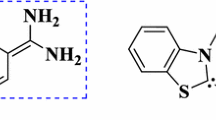Abstract
The title compound, a salt of C13H20O2 2+ 2Cl− 0.5 H2O, (I), crystallizes in the monoclinic space group C 2/c with unit cell parameters a = 34.091(4) Å, b = 7.2312(4) Å, c = 12.5827(5) Å, β = 96.870(6)°, Z = 8. The dihedral angle between the mean plane of the benzyl ring and the piperazin-1-yl group is 80.4(2)°, while the angle between the mean planes of the carbonyl group with that of the benzyl and piperazin-1-yl rings measure 6.6(3)° and 76.8(3)°, respectively. A short C=O and slightly extended C–O carboxyl bond in concert with weak intermolecular C–O···Cg π-ring interactions influences this twist angle with the benzyl ring and provides a slight interaction with the π conjugation of the benzene ring. Hydrogen bonding has no effect on the carboxylic group. Two separate two-center (acceptor bifurcated) Cl−···H–(N,O) hydrogen bonds are observed between one chloride anion and a water molecule and the piperazin-1-yl ring and a second chloride anion with a carboxyl oxygen atom and the piperazin-1-yl ring. These direct intermolecular couplings link the molecule into chains along the [010] plane of the unit cell which influence the twist angles of the benzyl and piperazin-1-yl rings and help stabilize crystal packing in the unit cell.
Graphical Abstract
Crystal Structure of 4-[(4-methylpiperazin-1-yl)methyl]benzoic acid dihydrochloride hemihydrate is reported and its geometric and packing parameters described and compared to a MOPAC computational calculation.




Similar content being viewed by others
References
Curran MP, Croom KF, Goa KL (2003) Am J Cancer 2:439–454. doi:10.2165/00024669-200302060-00005
Druker BJ, Tamura S, Buchdunger E, Ohno S, Segal GM, Fanning S, Zimmermann J, Lydon NB (1996) Nat Med 2:561–566. doi:10.1038/nm0596-561
Druker BJ, Sawyers CL, Kantarjian H, Resta DJ, Reese SF, Ford JM, Capdeville R, Talpaz M (2001) N Engl J Med 344:1038–1042. doi:10.1056/NEJM200104053441402
Peggs K, Mackinnon SN (2003) Engl J Med 348:1048–1050. doi:10.1056/NEJMe030009
Kalaycio M (2004) Curr Hematol Rep 3:37–38
Sairam P, Puranik R, Kelkar AS, Sasikiran S, Veerender M, Parvathi A (2003) Synth Commun 33:3597–3605. doi:10.1081/SCC-120024747
Sheldrick GM (2008) Acta Crystallogr A64:112–122
Bruker (2000) SHELXTL Version 6.10. Bruker AXS Inc, Madison
Allen FH, Kennard O, Watson DG, Brammer L, Orpen AG, Taylor R (1987) J Chem Soc Perkin Trans 2:S1–S19
Cremer D, Pople JA (1975) J Amer Chem Soc 97:1354–1358
Schmidt JR, Polik WF (2007) MNDO approximation together with the Hartree-Fock closed-shell restricted wavefunction was used and minimizations were teminnated at an r.m.s. gradient of less than 0.01 KJ mol−1 Å−1. WebMO Pro, version 8.0.010e; WebMO, LLC, Holland, available from http://www.webmo.net
Acknowledgments
LM thanks the University of Mysore for use of their research facilities. RJB acknowledges the NSF MRI program (grant No. CHE-0619278) for funds to purchase an X-ray diffractometer.
Author information
Authors and Affiliations
Corresponding author
Electronic supplementary material
Below is the link to the electronic supplementary material.
Rights and permissions
About this article
Cite this article
Jasinski, J.P., Butcher, R.J., Mallesha, L. et al. Dual Chlorine-Bifurcated Acceptor Cl···H–(N,O) Hydrogen Bonds in 4-[(4-Methylpiperazin-1-yl) Methyl]benzoic Acid Dihydrochloride Hemihydrate. J Chem Crystallogr 39, 773–776 (2009). https://doi.org/10.1007/s10870-009-9565-5
Received:
Accepted:
Published:
Issue Date:
DOI: https://doi.org/10.1007/s10870-009-9565-5




